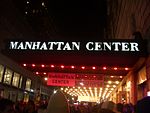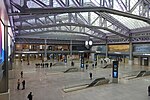34th Street–Penn Station (IND Eighth Avenue Line)
1932 establishments in New York City34th Street (Manhattan)Accessible New York City Subway stationsEighth Avenue (Manhattan)IND Eighth Avenue Line stations ... and 4 more
Midtown ManhattanNew York City Subway stations in ManhattanRailway stations in the United States opened in 1932Use mdy dates from December 2018

34th Street–Penn Station is an express station on the IND Eighth Avenue Line of the New York City Subway, located at the intersection of 34th Street and Eighth Avenue in Midtown Manhattan. It is served by the A and E trains at all times, and by the C train at all times except late nights. The station is adjacent to Pennsylvania Station, the busiest railroad station in the United States as well as a major transfer point to Amtrak, NJ Transit, and the Long Island Rail Road.
Excerpt from the Wikipedia article 34th Street–Penn Station (IND Eighth Avenue Line) (License: CC BY-SA 3.0, Authors, Images).34th Street–Penn Station (IND Eighth Avenue Line)
8th Avenue, New York Manhattan
Geographical coordinates (GPS) Address Nearby Places Show on map
Geographical coordinates (GPS)
| Latitude | Longitude |
|---|---|
| N 40.752166 ° | E -73.993521 ° |
Address
34th Street - Penn Station
8th Avenue
10119 New York, Manhattan
New York, United States
Open on Google Maps








